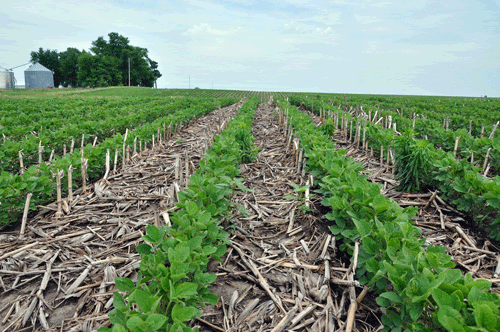
NoTillSoybeans147 NRCS.gif
(This article was originally published on Forbes on 7/18/22)
 |
| No-till Soybeans Following Corn (NRCS image) |
1870
was the first US Census in which farmers were in the
minority
(47.7%).Today, only 1.3% of Americans
are still farming and
increasingly do so on operations of over 2,000 acres. Even so, family farms still make up 98% of
our agricultural sector. Farm ownership still reflects the legacy of the Homestead Act of 1862 as a great deal of current
farmland still belongs to descendents of the 19th century
homesteaders. According to the most recent USDA Census of Agriculture in 2017,
the largest share of the US agricultural land is owned by families and
individuals (201.5 million acres of cropland and 223.8 million acres of
pastureland). Partnerships and family corporations own most of the remaining
private land with non-family corporations holding only 3.1 million acres of
cropland and 6.4 million acres of pastureland (see graph below)
 |
|
US agricultural land is mostly in the hands of families and individuals, many with ties to to historic farming families GRAPH BY AUTHOR BASED ON USDA DATA |
The
remaining farmers have typically expanded their operations by renting additional
acres rather than by purchasing land. That approach makes perfect sense in the
high risk, moderate reward business of farming the likelihood of a year with
bad weather or low commodity prices makes it too risky to take on a big
mortgage. In the USDA’s TOTAL Survey from 2014, rented land accounted
for around 28% of US pastureland (~144 MM Acres) and 54% of US cropland (~214
MM Acres). That survey also found that
31% of farmland (pasture and crop) was rented from “non-operator landlords” and
8% from farmers (see graph below)
 |
|
The land that farmers rent is mainly from non-farmers (31%) and the landlords are either individuals, partnerships, family corporations or trusts FROM THE USDA TOTAL SURVEY SUMMARY |
Farm
operations that rent some or all of their acreage dominate in all but the
smallest farm size categories (See chart below with partial rental operations
in light blue and full rental operations in orange).
 |
The majority of farming operations include at least some rented land. (USDA ERS and NASS)
The
landlords who lease this property are a mix of still-active farmers, retired
farmers, farm widows, city-dwelling descendants of farm families, and some
unrelated investors. Many of these landlords have a hands-off relationship with
their farmer tenant and simply collect their annual rent payment directly or through
a farm management company. In an age of climate change there are good reasons
to consider a more active role for these owners.
Agricultural
Land Value In An Age Of Climate Change
Agricultural
land is an asset with both short and long-term value. It generates annual
income for the farmer and a significant portion of that is applied to rent if the
property is owned by someone else. Ag land rental rates are closely tied to
historic and regional production history – better land commands higher rent. Around 1/2 of the cropland in the highly
productive Midwest is rented and the percent of land rented from non-farmer
owners is highest in the states with the highest rental rates driven by their
productive potential (see graph below).
In the major farm states, the percent of land leased from non-farming owners is highly correlated with rental rates which are linked to yield potential for key crops
| GRAPH BY AUTHOR BASED ON USDA DATA |
property value of agricultural land has been increasing at a brisk
pace in recent years
making it interesting for a range of investors. A projection from the 2014 USDA survey of land ownership and tenure was
that around 9.3 million acres of land would change ownership between 2015 and
2019 and that 60% of that would be through gifts, trusts, or wills, but that
some of that may then be sold by the new owners, increasing the supply of land
available for purchase. Land values and land rents are highly correlated (see
graph below)
Risk
and Opportunity
Climate
change is creating both new risks and new opportunities related to the annual
and long-term value of agricultural land. On the risk side, agricultural
productivity in any given growing season is intimately linked to weather. The
shifting climate exposes crops to more frequent extreme weather events
(drought, flooding, wind…), yield-robbing warmer nights, and increases in the
range and severity of pest challenges. Farmers can get some relief through
government subsidized crop insurance, but there could eventually be the need
for some risk sharing by landlords.
On the
opportunity side, plants can capture carbon dioxide from the atmosphere and
store it underground in relatively stable forms of organic matter – this is one
means of climate change mitigation through carbon sequestration. There are
certain farming systems that focus on the improvement of soil-health, and they do
a particularly good job of carbon sequestration. If this kind of “climate-action
farming” could be implemented at large scale (e.g. 100+ million acres), it
would be of great benefit for society as a whole. There is a further upside
associated soils that have captured and stored a lot of carbon – they become
more resilient in the face of climate change because they are better able to
capture and store rainfall in ways that buffer crop yields in both excessively
wet and dry years. The land becomes more “climate-resilient.” While there is no
one system suited to all situations, the basic elements are keeping plants growing
in a field to feed the soil ecosystem for as much of the year as possible
(double cropping, cover crops), having different species there over time including
some which are particularly deep rooted (diverse rotations), and most
importantly doing all of this with little to no mechanical soil disturbance in
the form of plowing or tillage since that sort of operation leads to the
release of sequestered carbon. There are also benefits from certain livestock
integration practices.
The
Transition Challenge
While
dual climate-resilient/climate-action farming systems are very attractive
as concepts, it is not at all trivial for a farmer to implement them in the
real world. They must also be customized to fit different soils types, regional
climates and primary cropping options. These changes require upfront investment
in things like seeds or equipment. There may be reduced income from some of the
rotational crops chosen for their soil enhancement characteristics rather than
profitability. It also typically takes 3-5 years years for the yield and yield
stability benefits to kick in and so the key hurdle is financing the transition.
These changes are difficult enough to justify for land the farmer owns, but far
more difficult to justify for rented land. It will be increasingly important to
educate landowners that there will be a growing perverse
incentive for a future tenant to “mine” the soil of nutrients for a few years
by tilling — essentially what the original sodbusters did. That future conventional tiller will actually
pay more to lease the ground, knowing that his non-land operating costs will be
lower than on his/her other fields. An
unwitting landowner might think this is a good deal and switch tenants for a slightly
better rent offer — not appreciating the asset degradation the land is about
the suffer in the background. It is a
poor trade, but not very visible. This
has been a major source of friction in some communities.
Carbon
Offset Markets
There
are initiatives underway to pay farmers to sequester carbon, but there is considerable
skepticism as
to whether such programs offer enough money to justify the costs and
complications involved. There are also questions about whether these programs
can be administered in a way that is fair and verifiable. Hopefully carbon
markets will contribute towards more climate-ready farming, but other
mechanisms are needed to enable the extensive and timely adoption of climate-resilient
farming needed to protect the food supply.
Regenerative
Farming
The
farming methods described here are related to what is variously defined as “Regenerative
Farming.” Unfortunately there is an effort to link the regenerative designation
to organic through a certification process that would continue the
ideologically-driven technology limitations of organic. The organic business
model is to compensate the farmer for lower crop yields through consumer-paid
price premiums, and that is not a workable approach to drive the system change
on a large sale in row crops. The shift to climate-resilient farming methods
needs to be enabled by all the best available technologies including
biotechnology and well regulated crop protection chemicals.
Is
This Kind of Change Even Possible?
Yes,
there is reason to believe that this is possible based on a historical precedent
for a farming huge system paradigm shift that happened in mainstream
agriculture: “no-till farming”. That change was also a response
to a climate crisis of human origin – the Dust Bowl
phenomenon of the 1930s, and it demonstrates the fact that farmers can make
changes when they need to. This year marks the 60th anniversary of
the first “no-till” field grown in Kentucky in 1962. Growing crops without
plowing or tillage was such a radical idea that early adopters had to avoid
social gathering spots like coffee shops to avoid getting harassed about their
“trashy fields.” Fast forward to 2017 and 104.5 million US acres were farmed
using a no-till approach. No-till or the
related Strip-till farming methods are the ideal
foundation for the full suite of climate ready systems, and so it is important to consider what
enabled that kind of large-scale change. The key elements were applied public
research, the development of specialized machinery, and the availability of key
technologies such as herbicides and biotech crops. But perhaps most importantly, the change was pioneered
by a distinct and innovative subset of the farming population. Today there are
still self-identified “no-tillers” and “strip-tillers,” and they are at the adoption
forefront of other farming methods that enhance climate-resilience. Grower
oriented publications like No-till Farmer or Progressive Farmer are filled with narratives about
farmers that are working out the practical details of adding things like cover
crops or unusual rotations or livestock integration. The key is not to tell
growers how to farm, but rather to ask these leaders what works and what would
help them and others to move in the right direction in terms of a climate
change response.
How
Could Farm Leases Be Modified To Help Drive Change?
As
mentioned earlier, it can take several years for the crop yield benefits of
modified farming practices to kick in and typical leases are on an annual cash
basis. Longer leases would be a step in
the right direction, but probably not all that is needed.
As
the growing climate becomes more challenging, land with enhanced climate
resilience will become more valuable, both in terms of potential rent and as a
premium property. It would make sense to structure a lease to include some cost
sharing between the farmer and the owner during the transition process, and
then have some mechanism for the farmer to share in the for the increased rent
potential and land value. There would also need to be a cooperative lease model
for land that is going to be enrolled in a carbon market program. Getting
carbon credits requires a commitment to the “permanence” of the carbon sequestration
which is not something that a renter can promise since a subsequent renter
could return the land to full tillage and release the stored carbon back into
the atmosphere. A land owner who wants to have their land in a carbon program
will need to find a capable and willing farmer and it would be appropriate to
do that with some sort of cost and value sharing arrangement.
Another
possibility would be to identify farmers with the most experience with transitioning
to climate-ready farming methods, and engage them to upgrade land that hasn’t
been optimally farmed in the past. Once again a cost sharing arrangement would
be appropriate up front followed by some mechanism for the grower to share in
the upside value. It would also make sense to set up an apprentice-like
arrangement for young farmers to learn from those same experts.
Connecting
the Key Players
In
order for there to be widespread adoption of new lease models that support
climate-ready/climate-active farming, to be there needs to be a way to connect
progressive farmers with enlightened landowners and other entities. The goal is
not to tell farmers how to farm, but rather to enable them to optimize the
climate resilience of land in ways that make sense for specific settings. There
could be a role for environmental or climate-action NGOs to generate interest among
non-farming land owners and provide them with background information and lease
models. Federal and state agencies involved with agriculture as well as farm
industry organizations could help in the development of the new lease models.
The operators of carbon offset programs should clearly “be at the table” as
should individuals or organizations who want to invest in farmland. There could
be a role for entities pursuing corporate sustainability or climate goals.
There could be a role for climate-oriented charitable foundations. On the
surface these diverse groups might seem like “strange bread-fellows,” but with
a commitment to mutual listening and respect, they could join forces to make a meaningful
difference for the future of the food supply and the trajectory of climate
change.
Source link
2022-07-25 11:00:00
Karl Hoffman is a distinguished agriculturalist with over four decades of experience in sustainable farming practices. He holds a Ph.D. in Agronomy from Cornell University and has made significant contributions as a professor at Iowa State University. Hoffman’s groundbreaking research on integrated pest management and soil health has revolutionized modern agriculture. As a respected farm journalist, his column “Field Notes with Karl Hoffman” and his blog “The Modern Farmer” provide insightful, practical advice to a global audience. Hoffman’s work with the USDA and the United Nations FAO has enhanced food security worldwide. His awards include the USDA’s Distinguished Service Award and the World Food Prize, reflecting his profound impact on agriculture and sustainability.







